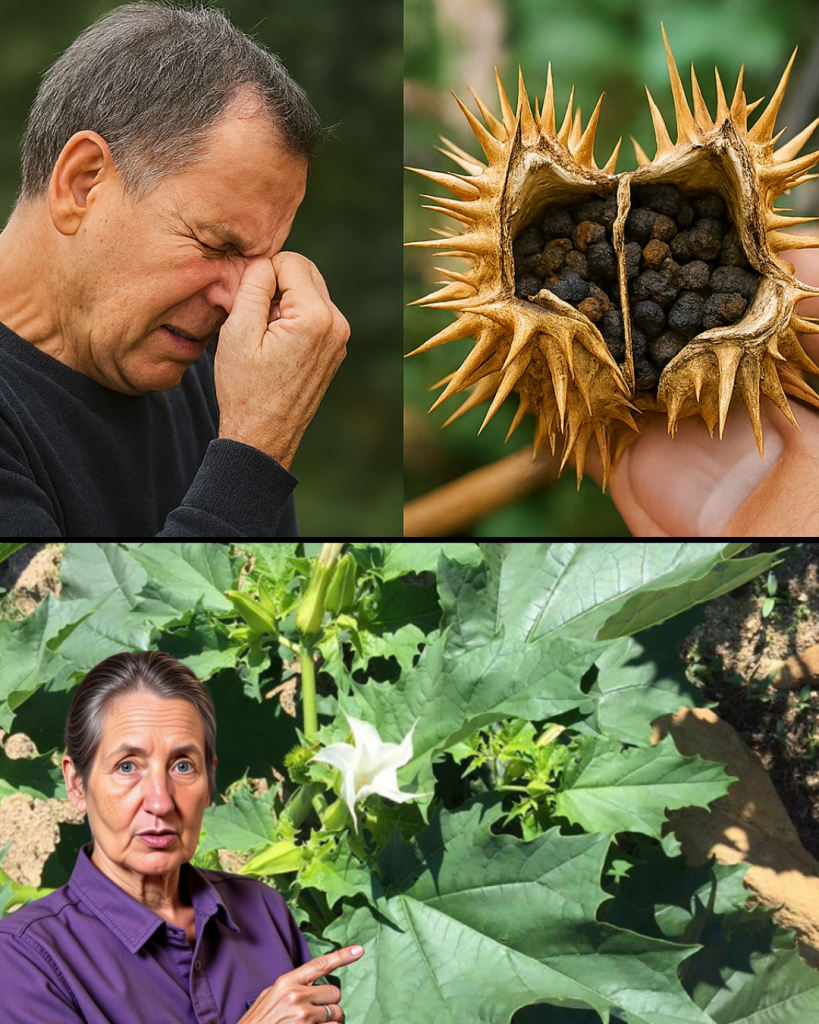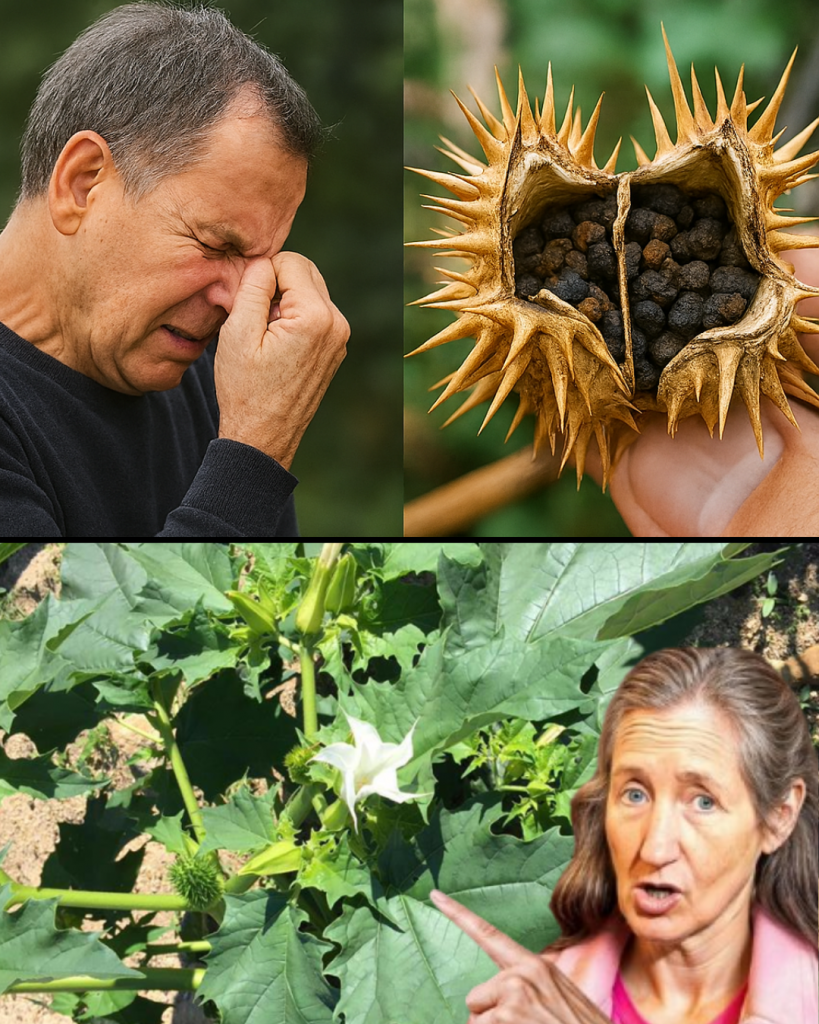Imagine strolling through a lush garden or a quiet hiking trail, captivated by a plant with mesmerizing trumpet-shaped flowers and curious spiky pods. It looks like something out of a fairy tale, but this beauty hides a deadly secret. Meet Datura stramonium, known as jimsonweed, thorn apple, or devil’s trumpet—a plant as enchanting as it is dangerous. Its allure has drawn in gardeners, adventurers, and even thrill-seekers, but its toxic nature can turn curiosity into catastrophe. Want to know how to spot this silent killer and keep yourself, your family, and your pets safe? Dive into this guide to uncover the truth about Datura stramonium and why it demands your respect.

🌸 What Makes Datura Stramonium So Deceptive?
Datura stramonium thrives in plain sight, popping up in backyards, along roadsides, or in abandoned fields across North America, Europe, and parts of Asia. This member of the nightshade family grows up to 5 feet tall, flaunting jagged leaves, fragrant white or purple trumpet-shaped flowers, and spiky seed pods that look like medieval weapons. It’s a plant that seems to whisper, “Look at me,” but every part—leaves, flowers, seeds, and roots—carries a dangerous secret.
The plant’s potency comes from powerful alkaloids like atropine, scopolamine, and hyoscyamine. These compounds, while historically used in tiny doses for medicinal or spiritual rituals, can wreak havoc on the human body. A single misstep—whether through ingestion, handling, or even inhaling its compounds—can lead to symptoms ranging from disorienting hallucinations to life-threatening conditions. Its beauty is a trap, and understanding its risks is your first line of defense.
💀 Why Is Datura Stramonium So Dangerous?
The danger of Datura stramonium lies in its ability to disrupt your body’s systems with chilling efficiency. Its alkaloids target the central nervous system, throwing your heart, lungs, and brain into chaos. Children, drawn to the plant’s odd seed pods, are especially at risk, as even a few seeds can trigger severe reactions. Adults aren’t immune either—gardeners, foragers, or thrill-seekers experimenting with its hallucinogenic effects often find themselves in emergency rooms.
Here’s what makes this plant so treacherous:
🌡️ Heart and Breathing Chaos: The alkaloids can send your heart racing, cause irregular breathing, or spike your blood pressure to dangerous levels.
🧠 Mind-Bending Hallucinations: Expect delirium, confusion, or vivid hallucinations that can persist for hours or even days, leaving you detached from reality.
💧 Parched and Flushed: Early signs include a bone-dry mouth, throat, and skin, often paired with flushed cheeks that signal trouble.
👁️ Vision Nightmares: Blurred vision or extreme light sensitivity can make it impossible to focus or see clearly.
⚡ Seizures or Worse: In extreme cases, high doses can lead to convulsions, unconsciousness, or, in rare instances, death.
Poison control centers across the United States handle thousands of calls annually related to Datura exposure, often from accidental encounters or misguided attempts at recreational use. The stakes are high, and ignorance is not bliss.
🛡️ Who’s Most Vulnerable to Datura’s Grip?
Datura stramonium doesn’t discriminate—it poses a threat to anyone who crosses its path. But certain groups face heightened risks due to their curiosity, exposure, or lack of awareness.
👶 Children: Kids are naturally drawn to the plant’s spiky pods or vibrant flowers, mistaking them for toys or snacks. Even a small nibble can lead to serious consequences.
🌱 Gardeners and Foragers: Those tending gardens or exploring wild areas may handle Datura without realizing its danger, especially without protective gear.
🐶 Pet Owners: Dogs and cats, curious by nature, may chew on Datura leaves or pods, leading to toxic reactions that mirror those in humans.
🎭 Thrill-Seekers: Teens or young adults chasing a hallucinogenic high often underestimate Datura’s unpredictable potency, landing them in medical emergencies.
If Datura grows in your area or lurks in your garden, staying vigilant is non-negotiable. Knowledge is your shield, and caution is your weapon.
🔍 How to Spot Datura Stramonium in the Wild
Recognizing Datura stramonium is your first step to staying safe. This plant has distinct features that make it stand out, but only if you know what to look for. Here’s your guide to identifying it:
🌺 Flowers: Look for large, trumpet-shaped blooms, 3–6 inches long, in white or pale purple. They open at dusk and close up during the day, adding to their mystique.
🍃 Leaves: Broad, jagged, and slightly lobed, the leaves give off a foul odor when crushed—a warning sign of their toxicity.
🌰 Seed Pods: Green, spiky, and egg-shaped, these “thorn apples” split open when mature to reveal tiny black seeds.
📍 Location: Datura loves sunny, disturbed soils—think roadsides, construction sites, or neglected corners of your yard.
Spotting Datura is only half the battle. Avoiding it requires action. Wear thick gloves when handling or removing it, and wash your hands thoroughly afterward. Teach children to steer clear of unknown plants, and keep pets away from suspicious greenery. If you find Datura in your garden, dig it up carefully, roots and all, and dispose of it in a sealed bag. Never burn it—the smoke can carry toxic compounds into the air.
🌼 Safer Alternatives for Your Garden
Love the look of Datura’s trumpet-shaped flowers but want to keep your garden safe? You’re in luck—there are non-toxic plants that mimic its aesthetic without the risks. These alternatives bring vibrant beauty to your space while keeping your family and pets out of harm’s way:
🌞 Morning Glory: These climbing vines boast stunning blue, purple, or white trumpet-shaped flowers that open in the morning, adding charm to any garden.
🌸 Angel’s Trumpet (Brugmansia): A close relative of Datura, this plant offers large, pendulous blooms in various colors. Handle with care, as it’s mildly toxic but far less dangerous.
🌙 Moonflower: Perfect for evening gardens, these white, fragrant flowers bloom at night, creating a magical atmosphere.
Before planting, check with your local nursery to ensure these options suit your climate and soil. A safe garden is a happy garden, and these alternatives let you enjoy beauty without fear.
🚨 What to Do If You Encounter Datura
Accidental exposure to Datura stramonium demands swift action. Whether it’s a curious child, a pet, or even yourself, knowing how to respond can make all the difference. Here’s your emergency plan:
🧼 Remove Contact: If you’ve touched the plant, wash your skin with soap and water immediately to minimize absorption.
💦 Rinse Mouth: If any part of Datura was ingested, rinse the mouth with water. Do not induce vomiting unless a medical professional advises it.
📞 Seek Help: Call emergency services or a poison control hotline (1-800-222-1222 in the U.S.) right away. Describe the plant and the exposure details clearly.
👀 Monitor Symptoms: Watch for signs like confusion, rapid heartbeat, or hallucinations. Keep the person calm and safe until help arrives.
Acting quickly can prevent minor exposure from escalating into a medical crisis. Don’t hesitate—time is critical when Datura is involved.

🌍 Datura’s Historical and Cultural Allure
Beyond its dangers, Datura stramonium has a storied past that adds to its mystique. Ancient cultures revered it for its psychoactive properties, using it in rituals to induce visions or connect with the spiritual realm. From Native American shamans to European herbalists, Datura was handled with reverence and caution, often reserved for those trained in its use. Its nicknames—devil’s trumpet, witch’s weed—hint at its dual nature as both a tool and a terror.
Today, Datura’s allure persists, but its risks far outweigh its benefits for the untrained. Its presence in folklore and history serves as a reminder: beauty in nature often comes with a price. Respecting its power means knowing when to admire from a distance.
🛠️ Practical Tips for Staying Safe
Protecting yourself and your loved ones from Datura stramonium is easier than you think. Here are practical steps to keep this deadly beauty at bay:
🧤 Use Protection: Always wear gloves when gardening or exploring areas where Datura might grow. Wash your hands and tools afterward.
👧 Educate Your Family: Teach children to avoid touching or tasting unknown plants. Make it a game to spot “dangerous” plants like Datura.
🐕 Pet-Proof Your Space: Regularly inspect your yard for Datura and keep pets on a leash in wild areas where it might grow.
🌿 Stay Informed: Familiarize yourself with the plants in your region. Apps or local gardening guides can help you identify risky species.
By staying proactive, you can enjoy nature’s wonders without falling victim to its hidden dangers.
✨ Why This Matters to You
Datura stramonium is more than just a plant—it’s a wake-up call to approach nature with curiosity and caution. Whether you’re a parent safeguarding your kids, a gardener curating a safe oasis, or an adventurer exploring the wild, knowing about Datura empowers you to make informed choices. Its beauty may tempt you, but its risks demand respect.
Take a moment to share this knowledge with someone you care about. A quick conversation could prevent a dangerous encounter. Want to dive deeper into safe gardening or plant identification? Explore our other articles for tips to keep your outdoor adventures worry-free. Stay curious, stay cautious, and let nature’s beauty inspire you—safely.









